What Is A Network? Network Types In Simple Language
Network means connecting two or more computers to share resources, files, or even an internet connection. Many Homes And Workplaces, In Turn, Have Networks To Connect To Their Computers.
However, there are four main types of networks available for users to use, which we will examine below.
Define a Network
A network can have a comprehensive definition. In its simplest form, it physically connects two or more computers with a cable or Wi-Fi connection. By connecting, these computers can share resources, files, and Internet connections without having to connect manually in any situation.
Networks become more complex as they grow in size. For example, a family home may have a network consisting of two home computers and a Wi-Fi connection (Used for devices such as smart TVs, streaming boxes, smartphones, etc.)., while an office building may have large networks of thousands of computers that are physically connected by Ethernet cables. Some networks can even cover large geographical areas.
It is essential to know the difference between the four main types of networks.
What are the types of Networks?
The most common types of networks are Local Area Network (LAN) and Wide Area Network (WAN). Metropolitan Area Networks (MAN) and Wireless LAN (WLAN) are the other two main types of networks, and Wireless WAN (WWAN) is a branch of the main types. In this section, a separate summary of each of the main types of network is given:
- Local Area Network: The common type of network you will encounter is a local area network, which includes interconnected computers relatively small area. That area can be your home, an office, or a school. Devices can be connected via Ethernet or Wi-Fi cable.
- Wide Area Network: This network covers large geographical areas, including city, province, or country. The Internet is considered to be the most extensive WAN in the world. With WANs, it is possible to connect LANs to them. Businesses may also have a WAN to connect their offices.
- Metropolitan Area Network: The MAN network is larger than LAN and smaller than WAN. Large companies or government agencies use it to connect different business resources.
- Wireless LAN: Wireless LAN works more like a local area network, but instead of using Ethernet cables, it does so over wireless connections, such as Wi-Fi or Bluetooth.
Why do we need a network?
Most likely, the only network you encounter daily, consciously, is a home network or LAN. Not everyone needs a home network. If you only have one computer and you do not have another device with which you want to be online or share resources, you do not need a network.
However, most people now have a home network setup with multiple devices connected to it. Just as you need to know how to implement a home network, it is also essential to know which cable or wireless connection, or a combination of both, is best for your home.
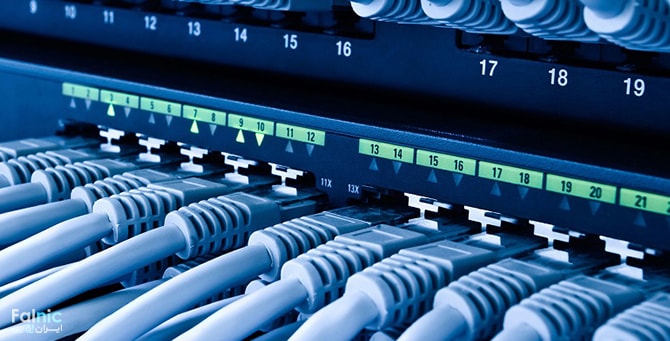
A network is a group of people or objects that can share information and communicate with each other. But in information technology, what is meant by the network?
Computer networks, or so-called networks, are computer systems, hardware, and software related to the network and communication equipment, such as network cables or wireless equipment. The network is generally divided into hardware (Passive) and software (Active).
Some of the passive pieces of equipment are cables, connectors, network sockets, racks ,and
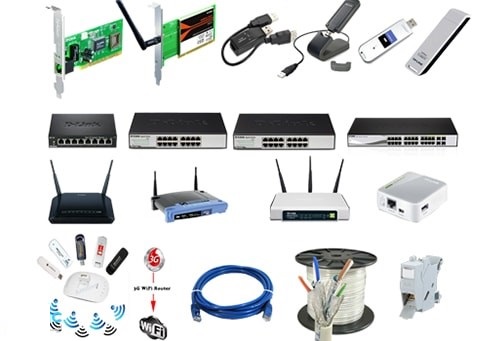
Computer networks consist of two parts: software and hardware.
Network History
If we look at the history of computer networks, we can refer to the late 1960s. During this time, the US Department of Defense launched its advanced research agency, Arpa, in competition with the Soviet Union’s satellite activities.
The agency carried out significant research projects in the strategic and defense fields, one of which was to establish strong connections during possible wars.
To that end, the first computer network was set up between four computers: two at MIT, one at the University of California, and one at the Stanford Research Center. This was the Arpanet network.
What is the use of networking?
What does networking do? The computer network is responsible for establishing connections between systems so that users can share data and equipment.
Network, set up computer networks, and communication between systems. Network users can share data and devices such as printers. IT managers can easily manage large numbers of computers and enforce their policies.

Today, the use of computer networks in all areas of communication in various sciences, such as military, medical, scientific, or even home and office applications, is clear to everyone.
Regardless of physical distance, computer networks can easily support two computers or an organization with 2 million computers or more. Networks are set up for a variety of purposes. Access data or make voice and video calls to each other. Files, files, hardware, software, etc., are shared on the network; users can use them at their access level.
Now that you know the purpose and benefits of computer networking, let’s examine the concept further.
Common computer network terms
In the following, we will examine the standard terms and expressions in networking.
What is a client?
A client is a system that receives a request and processes it before sending it to the collection server. For example, when connected to and using a network with your computer, your system is a client.
What is a server?
Server – Server always refers to a computer that has high hardware and software power and, as a central computer, provides services to clients. In client-server networks, the client and the server have their own operating systems.
In addition to being interconnected, computers are independent of each other, and that is if a computer or digital device connected to the network shuts down for any reason.
When the network goes out, the network is still running. But if the server goes out of the circuit, its services will also be out of reach and disrupt the network routinely.
What is a host?
Host – Any device or system connected to the network that provides or uses services within the network. By this definition, both the client and the server are considered hosts.
Types of computer networks
In this section, we want to examine the types of computer networks based on size and extent:
What is a PAN or personal network?
PAN stands for Personal Area Network and is the most minor type of network. Personal networks include a limited number of computers and digital devices that are a few meters apart and connect wirelessly.
For example, when you connect your mobile phone to a computer via Bluetooth, you have set up a personal network (PAN).

You create a personal network whenever you connect two digital devices wirelessly or wirelessly through technologies such as Wi-Fi or Bluetooth.
What is a LAN?
LAN stands for Local Area Network and is a collection of interconnected devices in a physical location, such as a building, office, or home.
The size of a LAN can be small or large, such as a home network with one user or an enterprise network with hundreds of users and devices. One of the technologies used in this type of network is Ethernet technology.
The critical point in defining a LAN is that the devices are connected in a limited area, unlike the WAN or MAN network, which covers large geographical areas. Some WANs and MANs connect multiple LANs.
What is MAN Network or Urban Network?
MAN stands for Metropolitan Area Network and covers an area the size of a city or a large area within a city. Examples of the MAN network are the connection of an institution’s branches to other branches within the city limits and the cable television network.
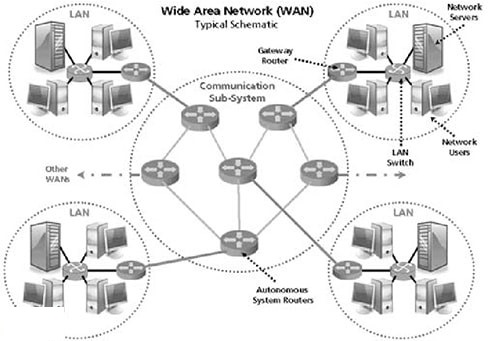

An urban network or man includes an area the size of a city.
What is a WAN?
WAN stands for Wide Area Network, is an interconnection of several LANs, meaning a network of networks. These networks are commonly used between cities, countries, or even continents. ISPs and telecommunications infrastructure must be used to connect WANs internally.
This network uses technologies such as ISDN, MPLS, and ATM. WANs include the Internet and 3G, 4G, and… services.
Extensive networks or wan are not limited to a specific area or city and specific location and can establish international connections.
What kind of network is Gan?
GAN, or Global Network, stands for Global Area Network and refers to global networks without geographical boundaries.
What is a wireless LAN?
LLAN for wireless LANs is an acronym for Wireless Local Area Network. One of the advantages of these networks is that users can move around and do not need a physical connection. Among the standards of this network is the 802.11a standard.
Types of networks based on function
In this section, we will examine the types of networks in terms of functionality.
What is Peer Peer Networks?
In this type of network, there is no centralized management and the clients are directly connected. There is no server in these networks and each client can play both server and client roles.
Peer-to-peer networks used for environments with less than 10 clients cost relatively little to set up. In the Windows operating system, this network is known as a Workgroup. The primary purpose of this type of computer network is to establish connections between digital systems and devices and to share files and data.
What are client/server networks?
These networks are usually set up in large environments where the two roles of the client as client/network user and server role as a server are considered. In client-server networks, servers are the place to store all network files, and all network users have a certain level of access.
What is a domain network?
Domain networks are a family of client-server networks where users can use network services. Network administrators can easily manage all users and ensure network Security and stability. Computers and digital devices in this network become domain members and receive a name and address under the domain name.

In client-server networks, a system specifically serves as a service provider, and its existence is required to provide client services.
What are internet-intranet-extranet networks like? This section will examine the Internet, intranet, and extranet networks.
What is the definition of an Internet network?
The Internet is one of the fastest and most global networks. People can easily send and receive data from one continent to another. A network can be connected with equipment such as a modem or a mobile Internet network. Popular Internet protocols include HTTP, HTTPS, and FTP.
What is the definition of an intranet network?
An intranet is a limited, private network typically set up by an organization or large corporation that uses protocols similar to the Internet. The difference is that data is not accessible outside of this network, and people outside the organization can not access the information on it.
For example, an intranet is an automation network between the branches of a bank, where only the employees of those banks have access to it.
What is the definition of an extranet network?
An extranet is a combination of the Internet and an intranet. An extranet is a secure network in cyberspace that certain people inside and outside the organization can access.
The difference between an intranet and an extranet is that the intranet is usually an internal network with collection servers inside the organization.
Although people outside the organization can not use this network, the extranet operates globally in cyberspace, and people outside the organization, such as business partners and customers, can also use the network in a secure environment.
What is a network topology in Network Types?
Network topology refers to how the components of a network are located, the physical architecture, and how they are connected.
Topology is an important element in the design and architecture of a network, and before setting up the network, one should pay attention to the network architecture.
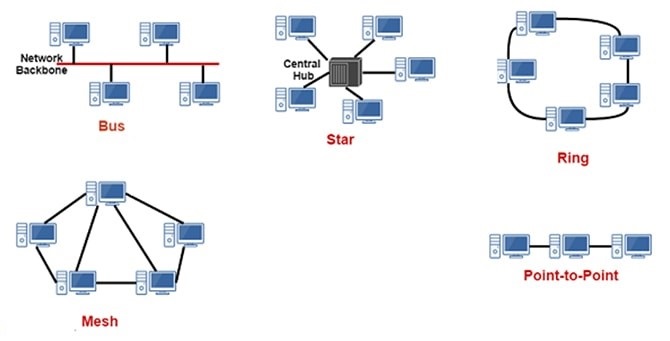
The network topology is the architecture and structure you choose for your network.
Types of network topology
In this section, we examine the types of network topologies.
1- Linear topology or BUS in Network Types
In the bus topology, all systems are connected to a core cable called a trunk or backbone. A Drop Line connects the computer to the main cable. Because all traffic passes through the main cable, the cable length and number of nodes are limited and have little scalability.
You also have trouble finding the error. If the trunk cable is disconnected, the entire network will fail, or the so-called down network. However, one of the advantages of this network is the low setup cost due to the lack of a special device.
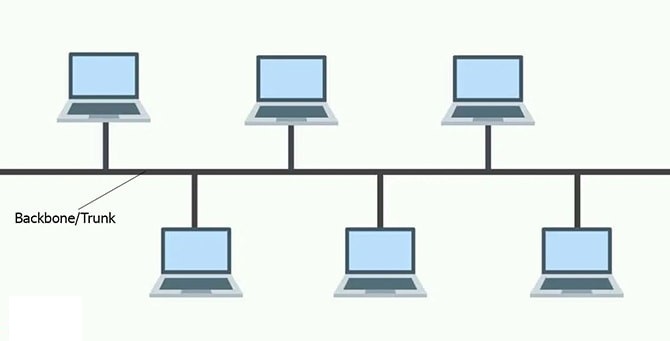
In the bass topology, troubleshooting is easy.
2- Star topology
All clients are connected to a central device in a star topology, usually a switch or hub. This topology is one of the most common network topologies. The benefits of stellar bonding include:
- The most important advantage of Star topology is its low cost. We only need an I / O port and a hub connection with a link.
- It is easy to install.
- Cabling is a bit necessary.
- If one link fails, other systems will have no problem, and the rest of the network will not be known.
- It is easy to manage and troubleshoot because the link is easily identified.
Disadvantages of star bonding include:
- If the central device fails, the entire network will be down.
- The hub needs more resources and regular maintenance because it is the central system of the Star topology.
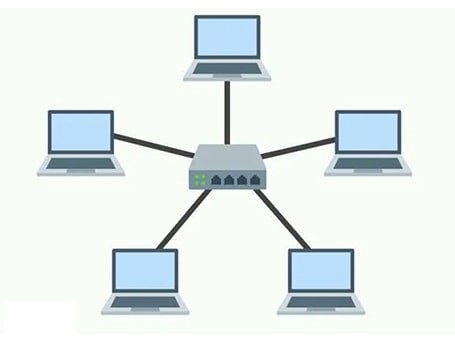
In star-shaped computer networks, all devices are connected to a central device.
3- token ring topology
In ring networks, clients connect to a device called MAU. In the ring topology, each device is connected to two other devices on both sides, and there is a unique link between them. Finally, these connections are in the form of rings, and this network has a ring structure.
As a result, if a device wants to send data to another device, this data is sent in one direction. Each device has a repeater, and if the received data belongs to another device, the repeater sends it to the next device, which is repeated until the data reaches its destination.
So wherever the packet wants to go, it must first receive the token and then bypass the individual CLIENTS to reach the desired destination.
The loop topology is easy to install and manage because you only need to change two links to add and subtract the device. But if a link breaks, the whole network is down. On the other hand, the volume of traffic within the network is high because the data must go around the entire loop.
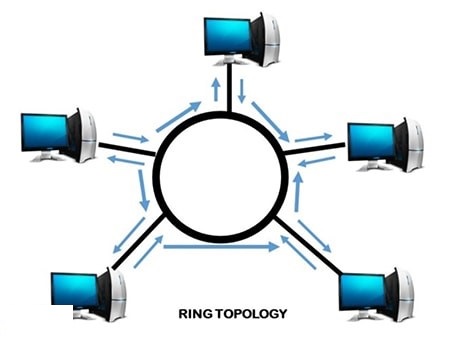
Token ring computer networks
Mesh Topology
In a mesh network, each client is connected directly to all other clients with a dedicated point-to-point link. If we have n devices, each is connected to n-1 other devices, and the number of links equals n (n-1) / 2.
The advantages of mesh topology are:
- A dedicated link means that it is used only by these two devices and data ,is only exchanged between them, so there is a no traff problem.
- If the link between the two devices is broken, it will not affect the network.
- It has high security because the link is point-to-point, and authorized access.
- Ne prohib is availableited work troubleshooting is easy.
- Has a high fault tolerance.
- Reliable and fast.
Disadvantages of mesh topology are:
- It will naturally cost more because more cables and ports are needed for clients.
- We have a problem with upgrades because point-to-point links connect many devices.
The Mesh topology itself is divided into two categories:
- Full mesh: All systems are directly connected to other systems.
- Partial mesh: Each system is connected to only a few systems, not all.

In a mesh topology, all systems are interconnected, like the blur that is drawn between them.
Hybrid or hybrid topology
In this topology, several topologies are combined to achieve the best network performance in different conditions. One advantage of a hybrid topology is that you can combine topologies according to your needs, so network upgradeability is easy because the existing network can be combined with a variety of topologies.
For example, in the image below, you can see the combination of Bus and Star topologies.

Hybrid topologies in computer networks include several types of topologies together.
Disadvantages of topology include:
- Troubleshooting is difficult.
- It isn’t easy to install.
- It has a complex design, so it is difficult and expensive to maintain.
Wireless topology
This topology is for wireless networks that are widely used today. One of the disadvantages of this topology is its low Security. In a wireless network, devices can communicate with each other in the following two ways:
Ad hoc:
In this topology, devices set up networks with each other without any equipment and only through a wireless network card.
Infrastructure:
In this topology, network components communicate through an access point. This type of topology is more stable and fast than the ad hoc topology.

